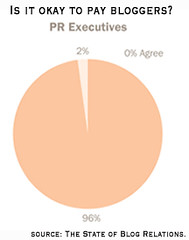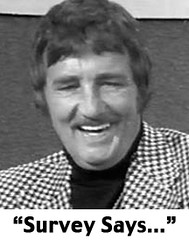Yesterday, Steve Rubel, author of Micro Persuasion, pointed to a pair of surveys that may be significant to public relations professionals. While both surveys include too few respondents to be considered an accurate measure on their own, they do mirror conversations I've read about the subjects.
Does their public relations firm do a good job identifying the specific interest of individual bloggers and sending them relevant information?
• Only 52 percent of the public relations professionals asked said yes.
• Contrary, 65 percent of the bloggers asked the same question disagreed.
If there is any hint of accuracy to the survey, it suggests that public relations practitioners may be creating the same divide between themselves and bloggers as some have between themselves and journalists. Maybe the division is occurring because public relations practitioners tend to spend more time talking up each other than developing relationships with bloggers. (That, by the way, is what bloggers tell me.)
The second survey, with the same participants, seems to mirror another discussion point that I’ve seen it come up from time to time: Paying for posts.
It is okay to compensate bloggers for writing about my clients, but it is not up to me to tell them to disclose the payment.
• Not one public relations professional thought it was okay to pay for posts.
• Contrary, 48 percent of bloggers thought it was okay; 16 percent were neutral.
What strikes me as odd about these survey results is that public relations practitioners who blog often take a stand against pay per posts, even with disclosure. Yet, some who maintain blogs write reviews about their clients.
The first survey was published in PR Week as part of APCO Worldwide’s new “The State of Blog Relations” blog, which defines itself as a “pioneering Web initiative aimed at capturing and analyzing thought leadership in the blogosphere.”
I don’t know; these questions have been asked for years. However, what I do know is that social media is being applied in some odd places and convincing some to draw odd conclusions.
Also from Rubel, recently, was the addition of advertising social media feedback mechanisms on advertisements. Although many praised the post in the comments, I think it’s one of the most ridiculous ideas ever.
Why? For two simple reasons. The CNET and AOL Network ad platforms allow non-customers to offer feedback on ads. Depending on the advertiser, this non-customer feedback may influence advertising that resonates with customers. That could lead to some dangerous conclusions.
Have we so soon forgotten the lessons learned from Miller when it attempted to target microbrewery beer drinkers with ads aimed at them? Not only did non-customers NOT buy Miller, but the ads alienated Miller’s core blue collar consumer. The net outcome was a lot of awards for the advertising agency, and one of the best ad campaigns, not for Miller, which footed the bill, but for its rival Budweiser, which quickly captured the alienated Miller drinker.
The measure of advertising seems much more simple to me. Did people click on the ad, visit the store, perhaps buy the product? And, if you are really curious how customers feel about your advertising, wouldn’t it be smarter to ask them as opposed to asking everyone, including people who are so outside of your demographic that it just doesn’t matter?
You know, “because we can” doesn’t always measure up as the right answer. Misapplied research can cause more damage than it's worth.

Does their public relations firm do a good job identifying the specific interest of individual bloggers and sending them relevant information?
• Only 52 percent of the public relations professionals asked said yes.
• Contrary, 65 percent of the bloggers asked the same question disagreed.
If there is any hint of accuracy to the survey, it suggests that public relations practitioners may be creating the same divide between themselves and bloggers as some have between themselves and journalists. Maybe the division is occurring because public relations practitioners tend to spend more time talking up each other than developing relationships with bloggers. (That, by the way, is what bloggers tell me.)
The second survey, with the same participants, seems to mirror another discussion point that I’ve seen it come up from time to time: Paying for posts.
It is okay to compensate bloggers for writing about my clients, but it is not up to me to tell them to disclose the payment.
• Not one public relations professional thought it was okay to pay for posts.
• Contrary, 48 percent of bloggers thought it was okay; 16 percent were neutral.
What strikes me as odd about these survey results is that public relations practitioners who blog often take a stand against pay per posts, even with disclosure. Yet, some who maintain blogs write reviews about their clients.
The first survey was published in PR Week as part of APCO Worldwide’s new “The State of Blog Relations” blog, which defines itself as a “pioneering Web initiative aimed at capturing and analyzing thought leadership in the blogosphere.”
I don’t know; these questions have been asked for years. However, what I do know is that social media is being applied in some odd places and convincing some to draw odd conclusions.
Also from Rubel, recently, was the addition of advertising social media feedback mechanisms on advertisements. Although many praised the post in the comments, I think it’s one of the most ridiculous ideas ever.
Why? For two simple reasons. The CNET and AOL Network ad platforms allow non-customers to offer feedback on ads. Depending on the advertiser, this non-customer feedback may influence advertising that resonates with customers. That could lead to some dangerous conclusions.
Have we so soon forgotten the lessons learned from Miller when it attempted to target microbrewery beer drinkers with ads aimed at them? Not only did non-customers NOT buy Miller, but the ads alienated Miller’s core blue collar consumer. The net outcome was a lot of awards for the advertising agency, and one of the best ad campaigns, not for Miller, which footed the bill, but for its rival Budweiser, which quickly captured the alienated Miller drinker.
The measure of advertising seems much more simple to me. Did people click on the ad, visit the store, perhaps buy the product? And, if you are really curious how customers feel about your advertising, wouldn’t it be smarter to ask them as opposed to asking everyone, including people who are so outside of your demographic that it just doesn’t matter?
You know, “because we can” doesn’t always measure up as the right answer. Misapplied research can cause more damage than it's worth.






























